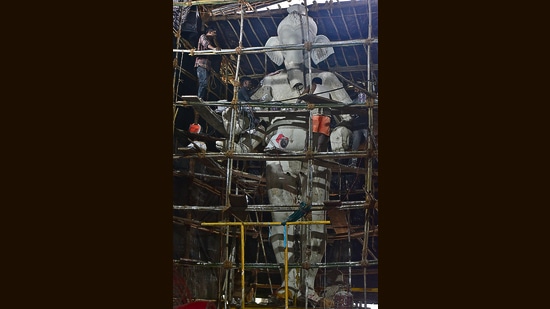Sena vs Sena battle gets a festive twist
The Thackeray-led government had, in 2021, imposed curbs on human pyramids during Gokulashtami in view of the high number of Covid-19 cases
Mumbai: The city may have been named after Mumba Devi, but Mumbai’s presiding deity, undeniably, is Lord Ganesh who has now been roped into the political battlefield where Shiv Sena and Shinde’s Sena are arrayed against one another.

One of chief minister Eknath Shinde’s earliest decisions after staging a palace coup was to lift all restrictions imposed by his predecessor, Uddhav Thackeray, on celebrations of the 10-day Ganesh Utsav that runs from August 31 to September 9, and also the dahi handi celebrations on Gokulashtami that falls on August 19, this year.
The Thackeray-led government had, in 2021, imposed curbs on human pyramids during Gokulashtami in view of the high number of Covid-19 cases. The previous year, it had also restricted the height of Ganpati idols to 4 feet (ft) for public mandals and to 2 ft for household idols. The immersion days see vast congregations of people headed to the seas, and the Thackeray government advocated that smaller statues at public mandals would keep the turnout low on visarjan days in keeping with Covid restrictions, and also maintained that smaller statues are less polluting.
However, Shinde well understands the political symbolism that imbues Ganesh Utsav in Maharashtra. After all, it was Lokmanya Balgangadhar Tilak who instituted the first public Ganesh mandal at Girgaum in Mumbai in 1893, and used the 10-day festival to unite the Marathi manoos, and rouse them to rally against the British. Shinde’s political cause may be more personal and rivalrous in nature, but his tactics are the same as Tilak’s.
“There will be no restrictions on Ganpati celebrations this year and the government is committed to providing all help to organizers of Ganesh mandals,” Shinde had announced in late July. He ordered the administration to repair the roads on which large Ganesh processions would pass, and waived the toll for devotees travelling between Konkan and Mumbai.
With the festival season less than a fortnight away, hundreds of ersatz Ganesh workshops have bloomed in Mumbai where artisans are competing to create gigantic idols, ensuring that last year’s miniature versions become a distant memory. Mumbai alone has 12,000 public mandals, and the man who administers all of them is Naresh Dahibhawkar, president of the Brihanmumbai Sarvajanik Ganeshotsav Samanvay Samiti. “With no restrictions on the height of the idols we will see idols as tall as 26 feet (that’s over 2-storey high) this time.” Unlike in the Uddhav government, there are no restrictions on the use of Plaster of Paris (POP) idols this time.
“Only 20 per cent of the artisans are using natural materials, the rest are using POP. The problem with clay is that those idols cannot exceed 12 ft, but this year since we have the freedom, artisans are using POP,” said Dahibhawkar, conceding that environmentalists have been crying hoarse about the polluting effects of POP idols.
In 2020, following a Central Pollution Control Board advisory, the Brihanmumbai Municipal Corporation (BMC) had banned POP idols, but in July, after Shinde took over as chief minister, the BMC rescinded that advisory and insisted that the idols be immersed in artificial ponds. At the same time, the BMC has reduced the number of artificial ponds in certain wards this year. Shinde himself announced the constitution of a committee to find ecologically-sound alternatives to POP, but the committee has been given three months to submit its report, well after the Ganesh festival ends. The POP idols will be banned from next year, promised the Ganpati festival organisers.
Similar exceptions have been made for the dahi handi groups this year. In 2014, the Bombay high court had restricted the height of human pyramids to 20 feet. But this year, Rajesh Narvekar, district collector of Thane, which is also where Shinde lives and has his political base, announced there will be no height restriction prompting a fierce competition among various groups to aim higher. In Thane, this is crucial because so far, the festival there has been controlled by Shiv Sena MP Rajan Vichare, who is still with Thackeray.
On Tuesday the chief minister announced that all dahi handi groups will be provided an insurance cover of ₹10 lakh, the premium for which will be paid by the state government. For two years, dahi handi was disallowed as it is a contact sport, but now with all restrictions lifted, there is great enthusiasm everywhere, said Surendra Panchal, secretary of Maharashtra’s Dahi Handi Samanvay Samiti. Mumbai alone has around 900 dahi handi groups, including several women-only groups. This year, political parties are vying to offer the highest prize money to the winners of the dahi handi competition.
BJP-run Swami Pratishthan has offered prize money of ₹51 lakh to the winning team while Shiv Sena MLA Pratap Sarnaik who has since defected to the Shinde camp has offered ₹21 lakh to any team that beats the record held by the men of an organization he runs called the Sanskruti Yuva Pratishthan. The chief minister himself is expected to be the chief guest at the dahi handi being organised by his son and member of Parliament, Shrikant Shinde, in Thane this year.
In contrast, the dahi handi organized by Rajan Vichare, the Uddhav-loyalist, is far more low- key. “We are not allowing pyramids higher than six tier and every participant will get token money,” he said. But Geeta Zhagade who is president of Parle Sports Club, and has been running women-only dahi handi groups said, “This is a sport, don’t bring politics into it. However, there is only one Sena and it belongs to Uddhav Thackeray”.





